Asian soybean rust – Phakopsora pachyrhizi
Background
Asian soybean rust (Phakopsora pachyrhizi), first described in Japan in 1902, is considered a major disease of soybean in tropical and subtropical regions. In susceptible varieties the fungus causes premature defoliation, early maturation, and significant reductions (up to 80%) in yield. This disease does not yet occur in North America.
Pest Distribution
In the Eastern Hemisphere Phakopsora pachyrhizi occurs from Japan to Australia and westward to India and China. It has also been found in Hawaii and Central and Southern Africa, and in recent years has spread into parts of South America. Detections have been reported from the following American states: Alabama, Arkansas, Florida, Georgia, Hawaii, Iowa, Illinois, Indiana, Kansas, Kentucky, Louisiana, Minnesota, Mississippi, Missouri, North Carolina, Nebraska, Oklahoma, South Carolina, South Dakota, Tennessee, Texas, Virginia. In 2009, soybean rust was found in three states and nine municipalities in Mexico.
Biology
Phakopsora pachyrhizi is an obligate parasite (i.e., it requires green host tissue to survive). Pustules formed on the leaves of infected plants produce spores which can be disseminated by wind over very long distances. The disease is not known to be spread by seed. Under conditions of warm temperatures and high moisture and humidity, new infections can arise every 9-10 days.
The fungus has a wide host range that includes many legume species, of which soybean (Glycine max) is the primary agricultural host. The perennial weed "Kudzu", which is present in the American south, is a known potential host for soybean rust. If soybean rust was introduced into North America, the fungus could over winter on this plant and be blown northward into the main soybean producing regions each growing season.
Detection & Identification
Symptoms
Field inspection is the best way to detect if this rust is present. The disease is characterized by the formation of brown angular leaf spots on the foliage, yellowing of leaves, and eventually defoliation.
Symptoms are more typically found on maturing plants. During the early onset of infection, soybean rust can be found on the lower, first leaves of the plant. As the plants mature and approach flowering, the lower leaves die and the infection advances up the plant.
The upper surface of infected leaves show a yellow mosaic discolouration. As the infection advances, leaves begin to turn yellow and lesions start to appear, particularly on the undersides of the leaflets, first as gray-green, then tan to dark brown or reddish brown spots - "rust". Lesions may also appear on petioles, pods, and stems. As the infection spreads to the middle and upper portions of the plant it leads to necrosis, and eventually defoliation.
During the early stages of infection before the onset of sporulation the rust lesions may be confused with other diseases such as brown spot or bacterial leaf spot. However, under magnification (x20) ,soybean rust can be identified by the presence of cone shaped structures, uredinia, open at the top. Masses of urediniospores will be present both within the cone and possibly on the top.
on soybean (upper leaf surface)
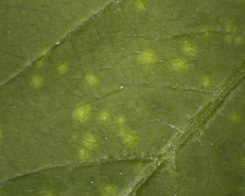
of the upper surface of a leaf.
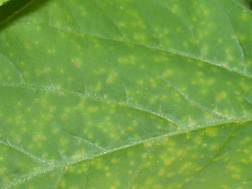
showing fungal pustules (uredinia).
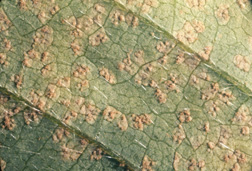
surface from another leaf.
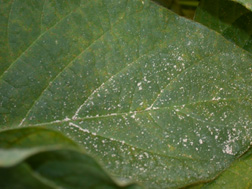
turning yellow with reddish-brown
lesions
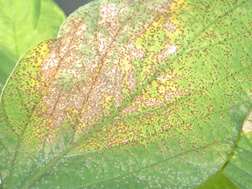
showing uredinia (cone shaped structures).
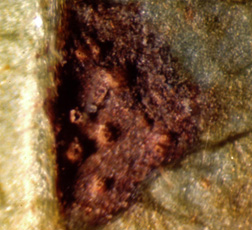
Text: Plant Pest Surveillance Unit, Science Branch
Photo Credits: Courtesy of United States Department of Agriculture (Agriculture Research Service & Animal and Plant Health Inspection Service)
- Date modified: